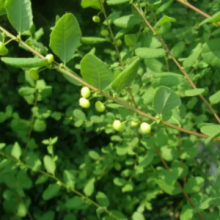身体不适时。请到正规医院就诊!不要耽误!
(Poor health. Please go to a regular hospital! Don't delay!)
本站是个人因爱好而建,非医药行业,不看病、不卖药、不受课、不参与任何商业,仅供参考!
(This site is built for personal love, not for the pharmaceutical industry, not for seeing doctors, not selling drugs, not taking classes, not participating in any business!)
Is the national
Phonetic symbols
Yi Ye Di
The alias
Leaf curl bead, small grain Artemisia, flower sweep strip, horse broom tooth, child boxing, leaf lower bead (" Chinese Medicine Zhi Zhi "), dog tongue strip (" Northeast Woody Plant Map "), eight leaf lower bead (" Zhejiang Tianmu Yam Sandalwood "), mountain broom strip (" Jilin Chinese Herbal Medicine ").
provenance
Annals of Medicinal Plants in Tianmu Mountain, Zhejiang Province
source
It is the tender leaves and roots of a Euphorbididae. Tender branches and leaves, late spring to late autumn can be harvested, cut even leaves of green shoots, tied into small handfuls, dry in the shade; Roots can be harvested all year round, silt removed, washed, sliced and sun-dried.
Habitat distribution
Born in thickets on hillsides and in sunny areas. Distributed in Northeast China, North China, East China, Hunan, Henan, Shaanxi, Sichuan and other places.
The original form
Shrubs, 1-3 m tall. Roots reddish brown, punctate and transverse long lenticels. Bark grayish brown, much irregularly split longitudinally. The stem is much branched, that year the new branch yellowish green, slightly angular. Leaves alternate, elliptic, orbicular or ovate-orbicular, 1.5 ~ 5 cm long, 1 ~ 2 cm wide, apex mucronate or obtuse, base cuneate, entire or with irregular orbicular teeth or fine obtuse teeth, both surfaces glabrous; Petiole short. Flowers small, unisexual, dioecious, without petals, male flowers every 3 to 12 clusters in leaf axils; Sepals 5, ovate; Disk glands of male flower 5, separated, 2-lobed, alternate with sepals; Ovary small, terete, 2-lobed; Female flowers solitary, or 2 to 3 in clusters, disk entire, ovary 3-loculed, style 3-lobed. Capsule triangulate oblate, ca. 5 mm in diameter, reddish-brown, glabrous, 3-valved. Flowering in July to August. Fruit period September to October.
character
The young branches are cylindrical, slightly angular, about 30 to 40 cm long, about 2 mm diameter at the thick end. Surface dark greenish-yellow, sometimes reddish, with longitudinal fine texture. Brittle, fibrous around the section, white center. The leaves are wrinkled and broken, and sometimes there are yellow flowers or grayish-black fruits. The air is slight, the taste is slightly pungent and bitter.
Roots irregularly branched, cylindrical, reddish brown surface, finely longitudinally wrinkled, sparsely protruding dots or transverse lenticels. Crisp quality, irregular section. Xylem yellowish white. Gas micro, taste light turn astringent.
The toxicity of
In cats, the number of persons causing convulsions was about 10.5 times that of strychnine, and the amount of death was about 100 times that of strychnine. Therefore, the treatment width was larger than that of strychnine. The median lethal dose was 6.3 mg/kg intravenously in mice, 25 mg/kg intraperitoneally in rats and 41 mg/kg intraperitoneally in rats. It was also said that the median lethal dose of intravenous injection in mice was 3.5 mg/kg. Toxicity was enhanced when mice were pretreated with SKF 525-A or liver damaged with carbon tetrachloride. The excitatory effect and toxicity (median lethal dose) of dihydrodiogarine on the central nervous system of mice were twice as strong as that of dihydrodiogarine. The growth, development, liver, renal function and red blood cells of the animals were not significantly affected by prolonged administration of monolidipine nitrate.
Chemical composition
The content of dipterine in leaves was the highest in flowering period and the lowest in fruiting period. The content of dipterine in dry leaves was generally 0.2-o. 3%. The young stem and mature fruit also contain dipterine, the content is not as high as the leaves. The leaves contained iRutin (1.32%), tannins, A small amount of Allosecurinine, Dihydroseeurinine and three kinds of monolipinol: Soeurinol A, monolipinol B, monolipinol C, etc.
The root contained a large amount of dipterine (O.42%), a small amount of dipterine and the methoxy compound of dipterine.
Seed oil content is 7.13%.
Sexual flavour
Hard, warm, toxic.
"Hunan Medicine Annals" : "Gan Wei Xin, Wen."
Function of the attending
Huoxue Shu tendons, spleen and kidney. Treat rheumatic lumbago, limb numbness, hemiplegia, impotence, facial paralysis, sequela of poliomyelitis.
"Treatment of leucorrhea in women."
② "Hunan Medicine" : "tonifying the kidney and strengthening the Yang, strengthening muscles and bones, and passing the blood."
Usage.
For internal use: decocted soup, 3 ~ 5 yuan.
compound
Treatment of infantile infantile chancre: five to six yuan for a single leaf diogastric grass root, purple green vine (rhamnodendron Gulingechu), white baiju bone root (Rubiaceae June snow), wild gonzi root (strychnodendron inebrium), rhizome or stem (legume Yunshi) five to six yuan each, fried 14 black soybeans (half-cooked) and 5 red dates. Water fry, flush brown sugar, morning, evening on an empty stomach each take once. (Annals of Medicinal Plants in Tianmu Mountain, Zhejiang Province)
(2) Cure impotence: five to six money for a leaf diogas root. The water decoction. (Hunan Journal of Medicine)
excerpts
Chinese Traditional Medicine Dictionary

